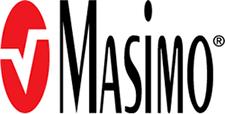
Landmark Study Shows Masimo SET® Pulse Oximetry and Patient SafetyNet™ Can Help Hospitals Dramatically Decrease Rescue Events and ICU Transfers, and ICU Days
Irvine, California – January 22, 2010 –Dartmouth-Hitchcock Medical Center and Masimo (NASDAQ: MASI), the inventor of Pulse CO-Oximetry™ and Measure-Through Motion and Low Perfusion pulse oximetry, jointly announced the peer-reviewed publication of an in-depth, 21-month clinical study on the impact of the Masimo Patient SafetyNet remote monitoring and clinician notification system. The study, featured in the February 2010 issue of Anesthesiology, is the first published report to demonstrate that continuous pulse oximetry monitoring and clinician notification in post-surgical patients on the general floor leads to a “significant drop” in key clinical outcome measures, including 65% fewer rescue events, 48% fewer ICU transfers, and reduced annualized ICU time by 135 days.1
In the study, Dr. Andreas Taenzer and a team of clinicians at Dartmouth-Hitchcock Medical Center used Masimo Patient SafetyNet—which combines the gold-standard performance of Masimo SET pulse oximetry at the point of care with remote monitoring and wireless clinician notification via pager—in a 36-bed post-surgical orthopedic unit. When comparing data collected for 11 months before and 10 months after implementation Patient SafetyNet in the 36-bed unit – as well as two other post-operative units with only standard monitoring equipment and protocols in place - researchers found that Patient SafetyNet-monitored patients experienced approximately 65% fewer rescue events (1.2 vs. 3.4 per 1,000 patient discharges) and 48% fewer ICU transfers (2.9 vs. 5.6 per 1,000 patient days)—freeing up 135 ICU days per year, while the two comparison units had no change.
“Masimo Patient SafetyNet represents a new approach to detect unrecognized post-operative deterioration—a significant precursor in morbidity and mortality for in-hospital patients,” stated the lead researcher and author of the study, Andreas H. Taenzer, MD, FAAP, Assistant Professor of Anesthesiology and Pediatrics at the Dartmouth Medical School, Dartmouth-Hitchcock Medical Center, in Lebanon, New Hampshire. “Our study results strongly demonstrate that continuous patient surveillance with Masimo Patient SafetyNet can greatly improve outcomes.”
In an accompanying editorial about the impact of the study, John P. Abenstein, MSEE, MD, at the Department of Medicine, Mayo Clinic, in Rochester, Minnesota, wrote that the “implications of this study are broad” and its results could “have important implications for hospital wards throughout the country.”2 According to Dr. Abenstein, “The literature and each of our own clinical experiences have examples of physicians on rounds, or nurses coming to check patients who have been dead for hours.” He continued, “We believe that Taenzer et al. have shown us a glimpse of the future” and “Not only will such systems allow us to improve the quality of care of our patients, but will also be a key to lowering costs.”
Masimo Founder and CEO, Joe Kiani, stated, “This is one of the most important studies ever published on pulse oximetry because it shows that with Masimo SET Pulse Oximetry technology, improving patient safety and reducing the cost of care can go together. There have been other studies that have shown the positive clinical and cost outcome in neonates and infants by using Masimo SET pulse oximetry, but this is the first time with adults. Over 20 years ago, we set out to solve the motion artifact and low perfusion problems of pulse oximetry, which were the bane of pulse oximetry and were thought to be unsolvable at the time. We thought by overcoming the motion artifact problem, we could improve patient outcome and reduce cost of care by taking noninvasive monitoring to new sites and applications. In fact, this became our mission statement. The clinicians at Dartmouth-Hitchcock, with their culture of patient safety, have shown a breakthrough in patient care is not only possible, but can be attained cost effectively. With this groundbreaking study, our vision is that in the near future, hospitals will utilize this important Patient SafetyNet technology to care for all of their patients, the same way airbags have become ubiquitous in cars today.”
1 Taenzer, Andreas H.; Pyke, Joshua B.; McGrath, Susan P.; Blike, George T. “Impact of Pulse Oximetry Surveillance on Rescue Events and Intensive Care Unit Transfers: A Before-and-After Concurrence Study.” Anesthesiology, February 2010, Vol. 112, Issue 2.
Available online at: http://journals.lww.com/anesthesiology/Abstract/publishahead/Impact_of_Pulse_Oximetry_Surveillance_on_Rescue.99692.aspx
2 Abenstein, John P.; Narr, Bradly J. “An Ounce of Prevention May Equate to a Pound of Cure: Can Early Detection and Intervention Prevent Adverse Events?” Anesthesiology, February 2010, Vol. 112, Issue 2. Available online at: http://journals.lww.com/anesthesiology/Citation/publishahead/An_Ounce_of_Prevention_May_Equate_to_a_Pound_of.99693.aspx
About Masimo
Masimo (NASDAQ: MASI) develops innovative monitoring technologies that significantly improve patient care—helping solve "unsolvable" problems. In 1995, the company debuted Measure-Through Motion and Low Perfusion pulse oximetry, known as Masimo SET®, which virtually eliminated false alarms and increased pulse oximetry's ability to detect life-threatening events. More than 100 independent and objective studies demonstrate Masimo SET provides the most reliable SpO2 and pulse rate measurements even under the most challenging clinical conditions, including patient motion and low peripheral perfusion. In 2005, Masimo introduced Masimo Rainbow SET® Pulse CO-OximetryTM, allowing noninvasive and continuous monitoring of blood constituents that previously required invasive procedures, including total hemoglobin (SpHbTM), oxygen content (SpOCTM), carboxyhemoglobin (SpCO®), methemoglobin (SpMet®), and PVI®, in addition to SpO2, pulse rate, and perfusion index (PI). In 2009, Masimo introduced Masimo Rainbow SET® Acoustic MonitoringTM, the first-ever noninvasive and continuous monitoring of acoustic res
